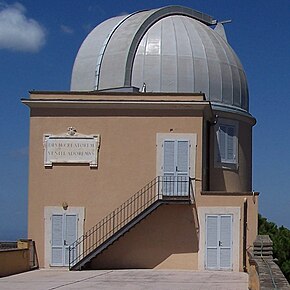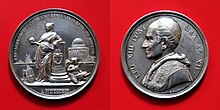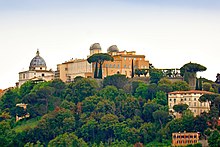Vatican Observatory
 | |
| Organization | |
|---|---|
| Observatory code | 036 |
| Location | Castel Gandolfo,Metropolitan City of Rome Capital,Lazio,Italy |
| Coordinates | 41°44′50″N12°39′02″E/ 41.747222222222°N 12.650555555556°E |
| Altitude | 430 m (1,410 ft) |
| Established | 1930 |
| Website | www |
TheVatican Observatory(Italian:Specola Vaticana) is an astronomical research and educational institution supported by theHoly See.Originally based in theRoman CollegeofRome,the Observatory is now headquartered inCastel Gandolfo,Italyand operates a telescope at theMount Graham International Observatoryin theUnited States.[1]
The Director of the Observatory is BrotherGuy Consolmagno,an AmericanJesuit.In 2008, theTempleton Prizewas awarded tocosmologistFr.Michał Heller,a Vatican Observatory Adjunct Scholar. In 2010, theGeorge Van Biesbroeck Prizewas awarded to former observatory director, the American Jesuit, Fr.George Coyne.[2]
History
[edit]This sectionneeds additional citations forverification.(October 2021) |
The Church has had a long-standing interest in astronomy, due to the astronomical basis of the calendar by which holy days andEasterare determined. For instance, theGregorian Calendar,promulgated in 1582 by PopeGregory XIII,was developed byAloysius Liliusand later modified byChristoph Claviusat theCollegio Romanofrom astronomical data. TheGregorian Towerwas completed in 1580 for his purpose, designed by Bolognese architectOttaviano Nonni.
In the 18th century, the Papacy actively supported astronomy, establishing the Observatory of the Roman College in 1774. In 1787–1789, theSpecola Vaticanain the Tower of the Winds within the Vatican was established under the direction of Msgr. Filippo Luigi Gilii (1756–1821). When Msgr. Gilii died, theSpecolawas closed down because it was inconvenient for students in the city because the dome ofSt. Peter'sobstructed its view. Its instruments were transferred to the College Observatory. A third facility, the Observatory of the Capitol, was operated from 1827 to 1870.
FatherAngelo SecchiSJ relocated the College Observatory to the top ofSant'Ignazio di Loyola a Campo Marzio(Church of St. Ignatius inRome). In 1870, with thecapture of Rome,the College Observatory fell into the hands of the Italian Government. Out of respect for his work, however, Father Secchi was permitted to continue using the Observatory. After Secchi's death in 1878 the Observatory was nationalized by the Italian government and renamed theRegio Osservatorio al Collegio Romano( "Royal Observatory at the Roman College" ), ending astronomical research in the Vatican.
In 1891, however,Pope Leo XIIIissued aMotu propriore-founding theSpecola Vaticana(Vatican Observatory) and a new observatory was built on the walls at the edge of the Vatican.[3]The new Vatican Observatory remained there for the next forty years.
In the late nineteenth-century the Vatican Observatory was part of a group of top astronomy institutions from around the world which worked together to create a photographic "Celestial Map" ( "Carte du Ciel") and an" astrographic "catalog pinpointing the stars' positions. Italian astronomer FatherFrancesco Denzaled the Vatican's contribution to the project until his death in 1894. In the early twentieth-century Father John Hagen took over the project and recruited a group of nuns from the Sisters of the Holy Child Mary to work on the necessary recording and calculations. The sisters were Sisters Emilia Ponzoni, Regina Colombo, Concetta Finardi and Luigia Panceri.[4][5]


By the 1930s, the smoke and sky-glow of the city had made it impossible to conduct useful observations in Rome.[1]Pope Pius XIrelocated the Observatory to Castel Gandolfo, which is 25 kilometres (16 mi) southeast of Rome. By 1961, the same problems withlight pollutionmade observing difficult at Castel Gandolfo. The Observatory then established theVatican Observatory Research Group (VORG),with offices at theSteward Observatoryof theUniversity of ArizonainTucson,Arizona.[1]
D.K.J. O'Connell produced the first color photographs of agreen flashat sunset in 1960.[6]In 1993, VORG completed construction of the 1.8 metres (71 in)Vatican Advanced Technology Telescope,which is atMount GrahamnearSafford, Arizona.
The Observatory's headquarters remain in Italy at Castel Gandolfo. In early 2008, the Vatican announced that the Observatory would be relocated to a former convent a mile away from the castle as part of a general reconstruction of the Papal residence. Its former space would be used to provide more room for the reception of diplomatic visitors. The old quarters in the castle were cramped and very poorly laid out for the Observatory's use. VORG research activities in Arizona continued unaffected.
Leadership
[edit]- Francesco Denza(1891-1894)
- Giuseppe Lais(1894-1906)
- Johann Georg Hagen(1906-1930)
- Johan Stein(1930-1951)
- Daniel Joseph Kelly O'Conell(1952-1971)
- Patrick Treanor(1971-1978)
- George Coyne(1978 – 19 August 2006)[7]
- José Gabriel Funes(19 August 2006[7]– 18 September 2015)[8]
- Guy Consolmagno(18 September 2015[8]– present)
See also
[edit]- Archaeoastronomy
- Catholic Church and science § Vatican Observatory
- Scientific Perspectives on Divine Action
- Vatican Advanced Technology Telescope
- List of astronomical observatories
- List of Jesuit sites
- Pietro Maffi
Notes
[edit]- ^abcJohnson, George (22 June 2009)."Vatican's Celestial Eye, Seeking Not Angels but Data".The New York Times.Retrieved24 June2009.
- ^Dennis Sadowski (4 January 2010)."American Astronomical Society honors former Vatican Observatory head".Catholic News Service.Archived fromthe originalon 7 January 2010.Retrieved6 January2010.
- ^History of the Vatican ObservatoryArchived18 December 2012 at theWayback Machine.Vatican Observatory Foundation. Retrieved 28 September 2013.
- ^"Mapping with the stars: Nuns instrumental in Vatican celestial survey".www.catholicnews.com.Archived fromthe originalon 29 April 2016.Retrieved26 December2019.
- ^Blakemore, Erin."These Little-Known Nuns Helped Map the Stars".Smithsonian Magazine.Retrieved26 December2019.
- ^Maunder, Michael (2007).Lights in the Sky: Identifying and Understanding Astronomical and Meteorological Phenomena.Springer. p. 72.ISBN978-1846287619.Retrieved28 September2013.
- ^ab"Rinunce e Nomine, 19.08.2006"(Press release) (in Italian). Holy See Press Office. 19 August 2006.Retrieved14 February2020.
- ^ab"Rinunce e Nomine, 18.09.2015"(Press release) (in Italian). Holy See Press Office. 18 September 2015.Retrieved14 February2020.
References
[edit]- Sabino Maffeo:The Vatican Observatory. In the Service of Nine Popes,Vatican Observatory Publications, 2001.

